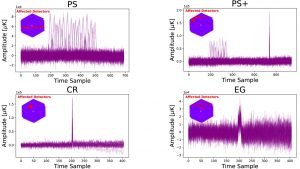
Zeinab is an undergraduate student who just completed her final year at York University, majoring in Astronomy and Astrophysics with a minor in Computer Science. Zeinab is particularly interested in the theoretical and computational aspects of astrophysics, including areas like dark matter, cosmology, and transient phenomena. This summer, Zeinab is working on a SURP project that applies machine learning to data from the Atacama Cosmology Telescope to help detect real astrophysical signals hidden in noisy observations.
What made you decide to participate in SURP?
I heard about SURP through a department email. I was drawn to the research environment and the chance to explore topics I had just started learning about in my cosmology course, such as the CMB, transients, and simulations.
Can you tell us about your research project?
I’m working on a project that analyzes the output of a machine learning classifier applied to time-ordered data from the Atacama Cosmology Telescope. The classifier flags potential astrophysical signals, and my role is to investigate these candidates further—checking their properties, evaluating variability, and helping determine whether they could be real astrophysical sources. This work may lead to the identification of new transient events that would otherwise be missed during standard data processing.
What is your favourite thing about SURP?
I’ve really enjoyed working with my research team. Everyone is supportive and willing to help, but they also encourage independent problem-solving. I’ve also appreciated the weekly seminars and the opportunity to join research group meetings—it’s helped me explore different areas and think more seriously about what I might want to do next.
Can you explain how SURP has been different from your undergrad work?
SURP has been more open-ended and interactive compared to undergrad courses. Instead of following fixed instructions, I’ve been asking questions, exploring data, and helping shape the direction of the work. I’ve also worked more closely in a team setting and gained hands-on experience with tools and methods I hadn’t used in classes.
What are your plans for the future?
I plan to pursue graduate studies in astrophysics, with a focus on theoretical and computational cosmology. This project has been a great introduction to real-world data analysis and transient science, and I’m excited to keep building on that in future research.
The Dunlap Institute for Astronomy and Astrophysics at the University of Toronto is an endowed research institute with over 80 faculty, postdocs, students, and staff, dedicated to innovative technology, ground-breaking research, world-class training, and public engagement.
The research themes of its faculty and Dunlap Fellows span the Universe and include: optical, infrared and radio instrumentation, Dark Energy, large-scale structure, the Cosmic Microwave Background, the interstellar medium, galaxy evolution, cosmic magnetism, and time-domain science.
The Dunlap Institute, the David A. Dunlap Department of Astronomy and Astrophysics, and other researchers across the University of Toronto’s three campuses together comprise the leading concentration of astronomers in Canada, at the leading research university in the country.
The Dunlap Institute is committed to making its science, training, and public outreach activities productive and enjoyable for everyone of all backgrounds and identities.


